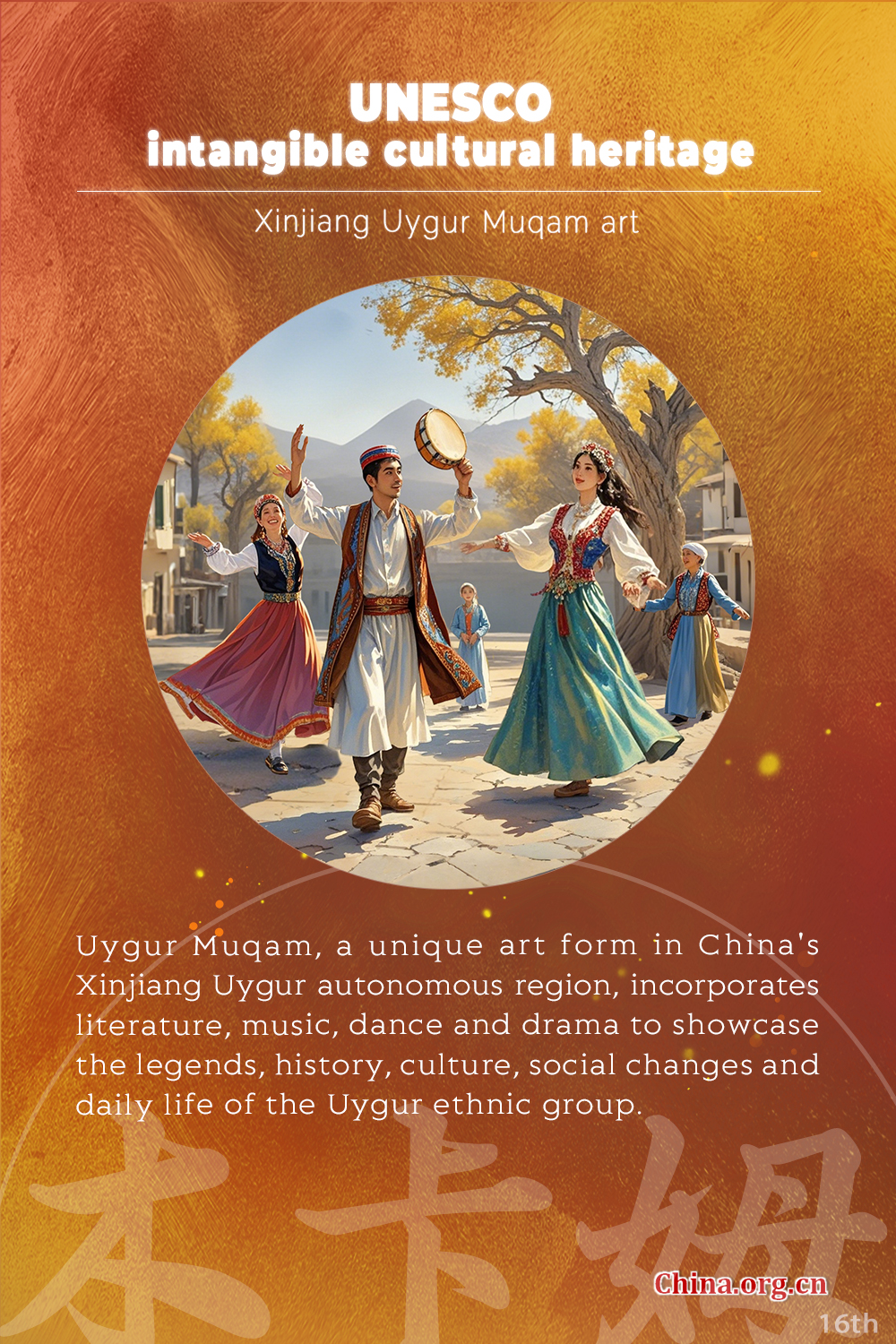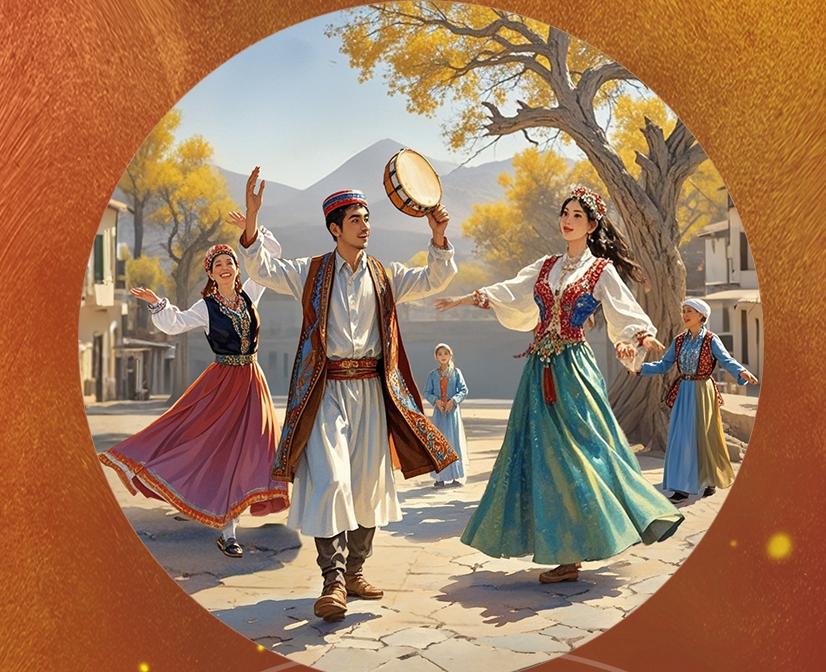
 0 Comment(s)
0 Comment(s) Print
Print E-mail China.org.cn, November 22, 2024
E-mail China.org.cn, November 22, 2024Editor's note: Muqam, meaning classical music in the modern Uygur language, combines literature, music, dance, drama and other art forms to showcase the legends, history, culture, social changes and daily life of the Uygur ethnic group in northwest China's Xinjiang Uygur autonomous region.

Three poems from Uygur Muqam read:
"Alright, this time, we'll change our way of narrating,
Just like I've ignored the scorching red sand at noon,
I choose to brighten up sadness with a bonfire at midnight,
And to dispel the gloomy past deeply rooted in my heart.
Listen, under the moonlight, I'm playing my qanun zither,
Singing, singing, with the howling of the desert wind.
The sound of ancient ocean waves
Weighs heavily on tonight's strings."
"Fruit aroma fills the autumn air,
But I only long for a little of your care.
You hold a blue horse in my story,
Taking it to its homeland.
The time flies backward today,
And the roofs in Central Asia seem far away.
Is my soul a Pamir flower?
Why does it always yearn for an eagle's flight?
Muqam, you are my true love,
Passionate and free, flowing melancholy and slowly."
"More feathers lift more dreams,
More dreams yield more happiness.
What makes the years lush green,
What keeps our love everlasting?
Why are oleaster flowers so refreshing,
And why do populus euphratica trees arouse your admiration?
The shimmering waves of the Yarkand River
Reflect the wisdom of history;
Muqam, the lover of the Tarim River Basin,
Your melody removes Taklamakan's desolation."
Muqam performers sing these poems to express their feelings and thoughts about life and nature. Their ancestors created many of these poems while crossing deserts, hunting or farming in mountains and grasslands, or fishing by rivers in the wilderness.
Records of Muqam date back to the fourth century, though some scholars trace its origins to the Han dynasty (206 B.C.-A.D. 220). Researchers widely recognize the contributions of Amannisahan (1533-1567), a king's concubine of the Yarkand Kingdom.
In the mid-16th century, Amannisahan, a master of music and poetry, invited many musicians and singers to collect and perform various Muqam pieces. They systematically developed and localized Muqam, making it more accessible. Their work resulted in 12 compositions that became the predecessor of today's "Twelve Muqam," also known as the "mother of Uygur music."
The Twelve Muqam varies across Xinjiang, incorporating local features and improvised performances. Each Muqam consists of three parts: Naghma (melody), Dastan (narrative) and Meshrep (singing, dancing and performances), with 25 to 30 sub-melodies each. These parts follow the same sequence in each Muqam, with a complete performance lasting more than 20 hours. Each melody and sub-melody can be performed independently.
Muqam can be performed solo or in groups with a lead singer. Performers sing poems, proverbs and ballads accompanied by instruments made from local materials, including bowed-stringed, plucked and wind instruments.
UNESCO added the Uygur Muqam of Xinjiang to its list of Masterpieces of the Oral and Intangible Heritage of Humanity in 2005. About 60 senior Muqam artists in Xinjiang contributed to the application, resulting in 2,200 minutes of recorded video and a collection of historical photographs.
In 1950, China's Ministry of Culture invited Wan Tongshu, Liu Chi and other musicians to document Uygur Muqam. They spent nearly six years with a senior Uygur folk artist, Turdi Ahun, to record and compile the scores and lyrics of the Twelve Muqam. Turdi Ahun was the only person who could sing all the melodies of the Twelve Muqam at that time.
Two volumes of the Twelve Muqam were published in 1960, documenting more than 340 classical songs, folk narratives, dance melodies and improvised compositions. This first written compilation preserved an art form that had been passed down only through oral tradition for about 2,000 years.
Since the 1980s, authorities have established Muqam research centers, art troupes, college programs and intangible cultural heritage (ICH) protection institutions while publishing a full range of books and audiovisual materials. The Twelve Muqam was designated as national-level ICH in 2006. In 2023, an ICH exhibition in Xinjiang's Aksu prefecture showcased 330 heritage items, including the Twelve Muqam.
Attendees at the event might have heard these verses:
"From whom have you learned to walk the righteous path?
From parents, seniors, tutors and the Twelve Muqam.
Where have you learned morality and politeness?
In places where song and dance are performed.
To the accompaniment of the Twelve Muqam."
Dilshat Parhat, head of the Muqam Art Troupe of Xinjiang Art Theater, said earlier this year that Uygur Muqam, once on the brink of extinction, has been revitalized through national protection and preservation efforts. His troupe has staged Muqam performances in dozens of countries and regions, showcasing the art form's unique charm to a global audience.
Discover more treasures from China on UNESCO's ICH list:
• 2022: Traditional tea processing
• 2020: Wangchuan ceremony, taijiquan
• 2018: Lum medicinal bathing of Sowa Rigpa
• 2016: Twenty-four solar terms
• 2013: Abacus-based Zhusuan
• 2012: Training plan for Fujian puppetry performers
• 2011: Shadow puppetry, Yimakan storytelling
• 2010: Peking opera, acupuncture and moxibustion, wooden movable-type printing, watertight-bulkhead technology of Chinese junks, Meshrep
• 2009: Yueju opera, Xi'an wind and percussion ensemble, traditional handicrafts of making Xuan paper, traditional firing techniques of Longquan celadon, Tibetan opera, sericulture and silk craftsmanship, Regong arts, Nanyin, Khoomei, Mazu belief and customs, Dragon Boat Festival, Manas, Craftsmanship of Nanjing Yunjin brocade, Xinjiang Uygur Muqam art

Go to Forum >>0 Comment(s)